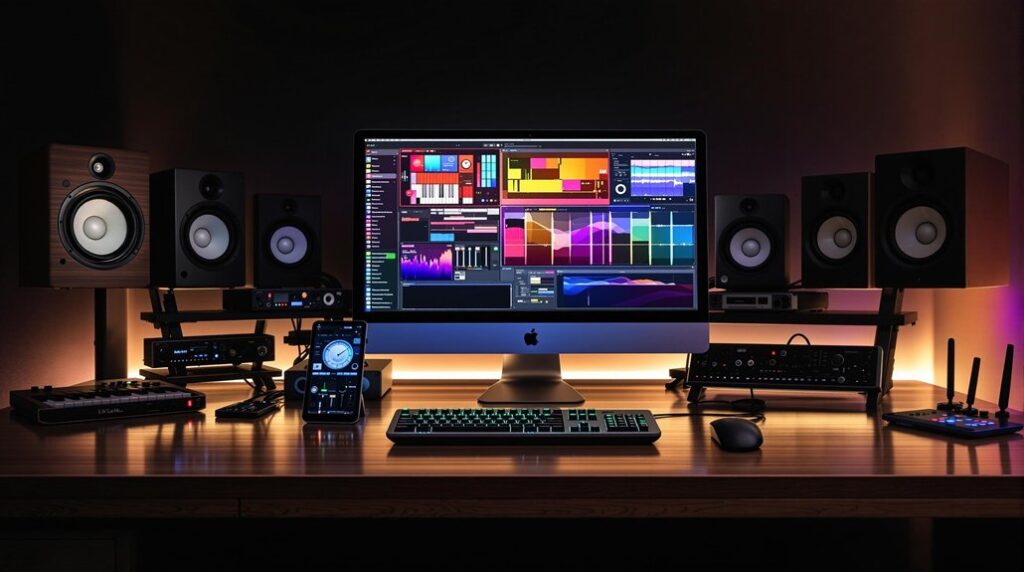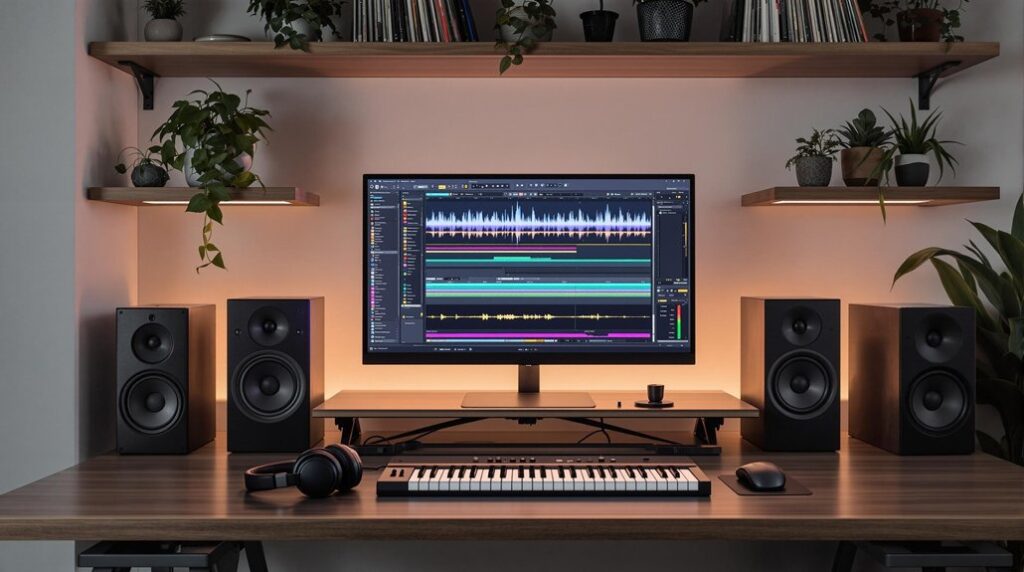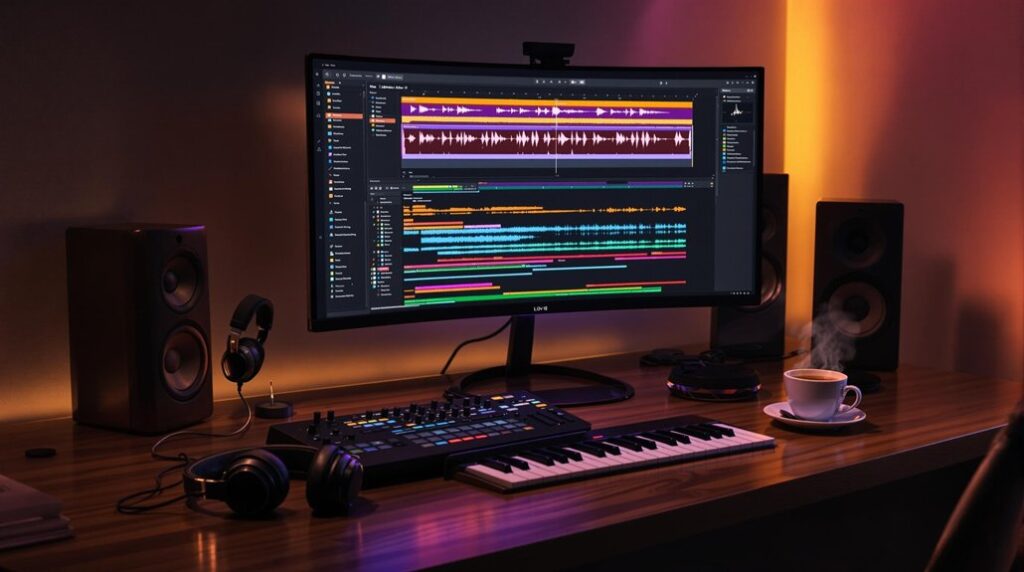DAW controllers offer musicians tactile interfaces, transforming complex DAWs into user-friendly setups. They connect via USB, enabling hands-on control with precision. Key features include motorized faders, transport controls, and customizable buttons. Integration with major DAWs like Ableton Live, Pro Tools, and Logic guarantees seamless functionality. By reducing dependency on peripheral devices, DAW controllers streamline workflows and enhance creativity. Future advancements in wireless connectivity and AI are anticipated, promising further optimization of music production processes. Discover more insights into DAW controllers.
Key Takeaways
- DAW controllers provide tactile interfaces, reducing reliance on mouse controls to enhance music production efficiency.
- They support major DAWs like Pro Tools, Logic, Ableton Live, ensuring seamless integration and functionality.
- Features such as motorized faders and transport controls enable real-time manipulation and easy navigation within DAWs.
- Customizable buttons and MIDI mapping allow personalized setups for unique workflows and creative processes.
- Future trends include wireless connectivity and AI integration for optimized workflows and remote collaboration.
Understanding DAW Controllers
Digital Audio Workstation (DAW) controllers serve as sophisticated peripherals that bridge the gap between traditional tactile interfaces and modern digital audio environments.
These control surfaces connect via USB, providing dedicated hardware controls that allow users to manipulate DAW software functions without the need for a mouse. This enhances music production efficiency by offering a tactile interface reminiscent of traditional mixing desks, promoting intuitive, real-time interaction.
DAW controllers support all major DAWs—Pro Tools, Logic, Ableton Live, and Cubase—often featuring plug-and-play compatibility. They vary in design, equipped with buttons, faders, encoders, and tracking controls, enabling thorough studio control.
Key Features of a DAW Controller
When examining the key features of a DAW controller, it is essential to reflect on the integration of motorized faders, transport controls, and customizable buttons, all of which contribute considerably to enhancing workflow efficiency and user interaction.
These control surfaces connect via USB, offering tactile manipulation of DAW functions. Models like PreSonus FaderPort 16 and AKAI APC Mini MK2 exemplify these features with touch-sensitive faders and RGB backlit pads, providing real-time MIDI control and visual feedback.
Compatibility with major DAWs such as Pro Tools, Logic, and Ableton Live is a standard, often featuring pre-mapped settings for immediate deployment.
The capability to have tactile access to controls considerably streamlines audio track adjustments, surpassing traditional mouse or keyboard methods.
Benefits of Using a DAW Controller
The integration of DAW controllers into music production environments greatly augments workflow efficiency by providing immediate tactile access to software functionalities, thereby reducing reliance on peripheral devices such as mice.
This tactile interface facilitates a more intuitive interaction with digital audio workstations, enabling real-time manipulation of parameters through dedicated controls for track levels, transport, and effects.
Consequently, users experience enhanced productivity and creativity, as these devices streamline complex processes and guarantee seamless compatibility across major DAWs like Ableton Live, Logic Pro, and Pro Tools.
Enhanced Workflow Efficiency
A myriad of advantages arise from incorporating DAW controllers into music production workflows, particularly in relation to enhanced efficiency. These devices, such as USB MIDI DAW Controllers, provide tactile control that optimizes the workflow by facilitating rapid access to mixing and editing functions. With dedicated controls, workflow efficiency is enhanced, reducing the time needed for track assembly and adjustments. Physical faders, knobs, and pads enable real-time sound manipulation, promoting intuitive creativity. Customizable mappings and keyboard shortcut support allow users to configure setups for specific needs, further enhancing workflow.
| Feature | Benefit |
|---|---|
| Tactile Interface | Faster access to DAW functions |
| Dedicated Controls | Streamlined production process |
| Real-Time Manipulation | Creative workflow enhancement |
| Customizable Mappings | Tailored efficiency |
| Software Integration | Seamless navigation |
Integration with major DAWs like Ableton, Logic, and Cubase simplifies operation, reducing complexity.
Intuitive Music Production
Building upon the efficiency enhancements previously discussed, the intuitive nature of DAW controllers considerably raises the music production experience by offering tactile interfaces that bridge the gap between digital and analog fields.
These devices transform software into a performance instrument, enabling precise manipulation of virtual instruments and effects. By providing physical knobs, faders, and buttons, a DAW controller facilitates intuitive interaction, allowing users to bypass cumbersome mouse navigation.
This tactile engagement accelerates the mixing and editing process, akin to utilizing keyboard shortcuts but with enhanced fluidity and immediacy. Seamless integration with major DAWs such as Ableton Live, Logic, and Cubase guarantees thorough functionality without complex configuration, further enhancing creative workflows and enabling real-time sound manipulation during live performances or recording sessions.
Choosing the Right DAW Controller for Your Needs
When selecting the ideal DAW controller, how does one navigate the myriad options to cater specifically to individual production requirements? A thorough analysis involves evaluating compatibility with major DAWs, guaranteeing seamless integration via USB connectivity.
Professionals prioritize controllers with features tailored to their unique workflow—motorized faders offer precision during mixing, while pad matrices facilitate sample triggering.
Budget considerations are paramount; controllers range from economical models at £29.99 to sophisticated units priced at £1,358.00.
Tactile feedback and ergonomic design are critical, enhancing the tactile interaction with virtual instruments.
Additionally, reviewing size and portability supports versatile usage scenarios, from studio environments to live performances.
Identifying these specifications guarantees the DAW controller aligns with one’s professional and creative aspirations.
Compatible DAWs for Control Surfaces
Control surfaces, integral components of modern music production, are universally supported by all major Digital Audio Workstations (DAWs), hence enabling streamlined workflows and precise auditory manipulation.
The compatibility spectrum encompasses industry titans such as Pro Tools, Logic, Ableton Live, FL Studio, Cubase, Bitwig, and PreSonus Studio One. Each DAW facilitates seamless integration with a variety of control interfaces, including the Professional MIDImix USB DAW, which enhances tactile command over the software environment.
Specifically, the controller for Ableton Live exemplifies a dedicated hardware-software synergy, optimizing user interaction for maximal creative output. While Ableton Push is a quintessential example of purpose-built hardware, third-party controllers offer MIDI mapping, ensuring flexibility and adaptability across diverse DAW platforms, hence serving as versatile tools for producers.
Understanding Ableton Live and its interface is crucial for maximizing creative flow and mastering the mix, especially when utilizing control surfaces for enhanced interaction.
Enhancing Workflow Efficiency With DAW Controllers
Revolutionizing audio production processes, DAW controllers provide a tactile interface that enhances the efficiency of mixing and editing operations beyond the limitations of traditional mouse interactions.
By offering dedicated controls such as faders, knobs, and buttons, controllers expedite access to critical tools, greatly enhancing workflow efficiency. The plug-and-play functionality of many controllers guarantees immediate deployment, eliminating the need for time-consuming driver installations. This capability allows users to seamlessly integrate into existing music production environments.
Controllers emulate the ergonomic layout of traditional mixing desks, fostering intuitive interaction with digital audio workstations (DAWs). Furthermore, their integration with industry-standard DAWs like Ableton Live, Logic, and Pro Tools guarantees seamless mapping, optimizing the production workflow by minimizing latency and maximizing precision in parameter adjustments.
Popular DAW Controllers in the Market
In the field of audio production, DAW controllers have become indispensable tools, offering specialized hardware interfaces that enhance the interaction with digital audio workstations.
Notable models stand out due to their unique features and compatibility with various software.
- Ableton Push: This DAW Controller is tailored for Ableton Live, integrating pads and touch-sensitive encoders for seamless USB Control.
- AKAI APC464: Known for its budget-friendly price, it features an 8×8 RGB pad matrix with extensive MIDI mapping.
- PreSonus FaderPort 8: Equipped with motorised faders, it is pre-mapped to work seamlessly with major DAWs, enhancing real-time mixing.
- Arturia Keylab Mk III: Combines keyboard and mixer controls, offering USB Control for diversified music production workflows.
These controllers exemplify innovation in tactile music interaction.
Integrating DAW Controllers With Software
DAW controllers enhance workflow efficiency by providing seamless software compatibility through USB connectivity and widely supported protocols like Mackie Control and HUI.
This integration facilitates real-time software interaction, allowing for precise control over DAW functions without the latency typically associated with software-only interfaces.
Additionally, the ability to MIDI-map third-party controllers to any software platform offers flexibility, enabling users to customize their workflows to suit specific production requirements.
Seamless Software Compatibility
Many modern DAW controllers exhibit seamless software compatibility, offering effortless integration with industry-standard digital audio workstations such as Pro Tools, Logic, Ableton Live, and Cubase. This integration is achieved through several key features:
- Protocol Support: DAW controllers like PreSonus Faderport utilize Mackie Control and HUI protocols, guaranteeing efficient setup without additional drivers.
- Customizable MIDI Mapping: This feature allows third-party controllers to be precisely configured for specific DAWs, enhancing user-specific workflow adaptability.
- Dedicated Design: Controllers such as Ableton Push are engineered for exclusive use with Ableton Live, offering profound integration and performance capabilities.
- Plug-and-Play Functionality: USB connectivity facilitates immediate interaction with software, minimizing configuration and maximizing production readiness.
These features collectively guarantee robust and versatile DAW controller performance across diverse production environments.
Enhanced Workflow Efficiency
Transforming digital audio production, DAW controllers offer a tactile interface that greatly enhances workflow efficiency by facilitating rapid adjustments of DAW functions, circumventing the limitations of mouse-based interactions.
Equipped with dedicated controls for mixing, editing, and timeline navigation, these controllers streamline the assembly and adjustment of audio tracks.
By integrating seamlessly with control software, particularly pre-mapped for popular platforms like Ableton Live, Studio One, and Logic Pro X, they eliminate extensive setup requirements.
Motorized faders and customizable buttons enable real-time manipulation of audio levels and effects, optimizing the mixing process.
This intuitive interaction with software not only augments creative possibilities but also greatly enhances workflow efficiency in sound design and editing, ultimately elevating the overall user experience in digital audio environments.
Real-Time Software Interaction
Integrating seamlessly with digital audio workstations, DAW controllers exemplify real-time software interaction by providing a tactile interface that bridges the gap between hardware and software. This is achieved through USB connectivity that allows for real-time manipulation of DAW functions.
Key elements include:
- Fader Controller: Devices like the PreSonus Faderport 8 with motorized faders enable precise control over track levels, supporting Mackie Control and HUI protocols for seamless compatibility with DAWs such as Logic Pro X, Cubase, and Pro Tools.
- RGB Backlit Pads: Units like the AKAI APC Mini MK2 enhance visual feedback, essential during live performances.
- Customizable Buttons: Immediate access to essential DAW functions enhances workflow efficiency.
- Intuitive Workflow: Faster access to effects and parameters compared to traditional mouse interactions.
Tips for Optimizing Your DAW Controller Setup
While refining a DAW controller setup, it is critical to first ascertain compatibility with the chosen Digital Audio Workstation by verifying specific mappings and support.
Utilizing the MIDI mapping capabilities, users can assign personalized shortcuts to frequently utilized functions, thereby enhancing workflow efficiency.
Customizable features, such as configurable faders and pads, enable precise assignment of functions tailored to individual workflow requirements, greatly boosting productivity during mixing and editing sessions.
To guarantee peak performance, regular updates of the controller’s firmware and software are imperative, aligning with the latest advancements in DAW features.
Experimentation with diverse layouts and configurations during live or studio sessions can reveal the most effective setup, consequently maximizing creative potential and streamlining production processes.
Future Trends in DAW Controllers
As users refine their DAW controller setups, it becomes pertinent to contemplate emerging trends that are shaping the future framework of digital audio workstations.
The integration of AI and machine learning is revolutionizing the MIDI Controller landscape, allowing for intelligent suggestions tailored to user preferences. Upcoming DAW controllers are anticipated to feature:
- Customizable Designs: Modular setups will enable users to adapt controllers to specific workflows, optimizing creative potential.
- Wireless Connectivity: Utilizing Bluetooth and Wi-Fi will enhance mobility, reducing studio cable clutter.
- Tactile Interaction: Touch-sensitive and haptic feedback technologies will mimic traditional consoles, enhancing intuitive control.
- Cloud Integration: Enhanced access for virtual and remote collaboration, allowing multiple users to work on the same session seamlessly.
These innovations will redefine the DAW controller paradigm.
Frequently Asked Questions
What Does a DAW Controller Do?
A DAW controller facilitates interaction with digital audio workstations by providing tactile interfaces like faders, knobs, and buttons. Its features enhance workflow, offering benefits like increased efficiency and intuitive setup, seamlessly integrating with various software environments for streamlined production.
What’s the Best DAW Controller?
The best DAW controller, according to user reviews, combines top brands’ best features like integration, MIDI mapping, and motorized faders. Popular options include Ableton Push, AKAI APC464, and PreSonus Faderport 8, each offering unique workflow enhancements.
What Is the Difference Between a DAW Controller and a MIDI Controller?
A DAW controller offers seamless software integration with specific DAWs, featuring a tactile user interface like motorized faders. In contrast, a MIDI controller requires MIDI mapping for versatile use across various platforms, focusing on triggering sounds and MIDI signals.
What Is the Difference Between a Digital Mixer and a DAW Controller?
A digital mixer features extensive audio routing options and live performance integration, handling multi-channel inputs/outputs, while a DAW controller specializes in software navigation, offering precise control over digital audio workstation parameters without direct audio handling capabilities.
Conclusion
To conclude, DAW controllers serve as pivotal tools for enhancing the tactile interfacing with digital audio workstations, offering precise control over software parameters. The integration of motorized faders, rotary encoders, and customizable buttons facilitates an intuitive workflow, optimizing audio production efficiency. Selecting an appropriate controller necessitates compatibility assessment with existing DAWs, alongside consideration of specific production requirements. As technology advances, expect innovations in wireless connectivity and haptic feedback, further bridging the gap between physical touch and digital manipulation in audio environments.




